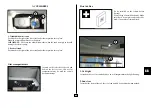
5
GB
Before using the machine
Do not drive the vehicle until the instructions and warnings contained in
this manual have been read and fully understood.
Vehicle control requires great care: prudence will help you avoid accidents.
Make sure you are aware of machine performance, limitations and necessary
steering space.
The steering zone has blind spots: it is therefore advisable to have someone
guide work when visibility cannot be ensured.
Lubricant, oil, mud or ice (in winter) on the footboard and handholds may
cause accidents. Keep them clean at all times.
Check the machine every day in order to make sure there are no oil or
hydraulic fluid leaks. Tighten and replace wherever necessary.
Make sure you understand on-site hand signals. This will ensure that you
are properly guided during precision machine manoeuvres or when direct
visibility is impaired.
Before transferring to another site or starting night work make sure that all
lights/indicators are working properly.
Before moving the vehicle always make sure that the doors, the engine
hood and the front inspection hatch are properly closed.
Never leave anything (tools etc.) lying on the machine or in the driver’s
seat.
Only the driver should be in the vehicle. Make sure that there is nobody
near or on the vehicle.
When getting in and out of the cab always use the footboard and the
handholds.
Check that all controls and safety devices are working properly and that
you are in a safe, obstacle-free area before starting work.
Keep well away from danger zones such as ditches, overhangs, subsidence-
prone areas etc. Inspect the work zone before using the machine and
carefully evaluate the risks.
Check out and weigh up all possible risks before driving the vehicle in a
new work zone. Holes, obstacles, rubble and other risk factors may cause
serious physical injury.
Be ready in case of an emergency! Always keep a first-aid kit nearby and
a fire extinguisher on board the vehicle, within the driver’s reach. Have
the extinguisher regularly serviced in compliance with the manufacturer’s
instructions.
Make sure you clearly understand the safety sticker symbols on the machine.
Make sure they are clean and legible at all times.
Always fasten your seat belt before starting. The vehicle is equipped with
a roll-over protection system (ROPS) which ensures safety. The seat belt
must not be too slack: it will protect the driver efficiently if fastened
correctly and worn at all times. The belt must not even be twisted or jammed
in the seat.
Operator must be in perfect physical conditions. In case of tiredness he/
she must not drive the vehicle. Should the operator have drunk spirits or
taken drugs/ medicines which could lower attention, he/ she must avoid
driving.
Make sure that you are fully aware of the position and function of all the
controls. Incorrect use of the controls could cause serious physical injury.
Periodically check tire pressure and wear.
In order to avoid accidents, dress properly. Do not wear too large clothes
which may be trapped by the machinery.
Maximise visibility by cleaning the windshield, windows and rear-view
mirrors.
In case of poor visibility do not use the vehicle.
Before driving the vehicle on the road fasten the loading gear into place and
make sure all safety devices are in place as required by the standards in
force.






















